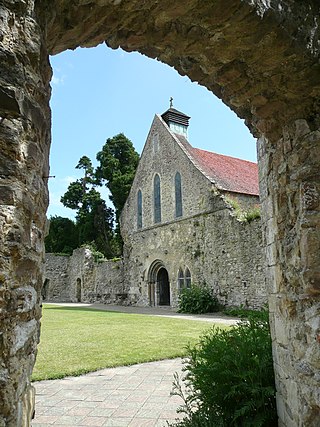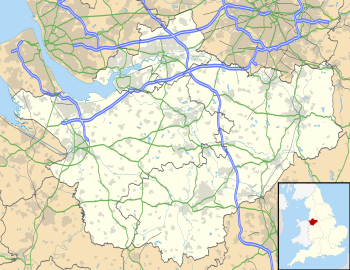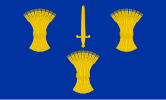
Basingwerk Abbey is a Grade I listed ruined abbey near Holywell, Flintshire, Wales. The abbey, which was founded in the 12th century, belonged to the Order of Cistercians. It maintained significant lands in the English county of Derbyshire. The abbey was abandoned and its assets sold following the Dissolution of the Monasteries in 1536.

Dryburgh Abbey, near Dryburgh on the banks of the River Tweed in the Scottish Borders, was nominally founded on 10 November (Martinmas) 1150 in an agreement between Hugh de Morville, Constable of Scotland, and the Premonstratensian canons regular from Alnwick Abbey in Northumberland. The arrival of the canons along with their first abbot, Roger, took place on 13 December 1152.

Beaulieu Abbey was a Cistercian abbey in Hampshire, England. It was founded in 1203–1204 by King John and populated by 30 monks sent from the abbey of Cîteaux in France, the mother house of the Cistercian order. The Medieval Latin name of the monastery was Bellus Locus Regis or monasterium Belli loci Regis. Other spellings of the English name which occur historically are Bewley and Beaulie.

Over is an ancient borough, mentioned in the Domesday Book, now a part of Winsford in the Cheshire West and Chester district, in the ceremonial county of Cheshire, England. Wharton forms the eastern part, the boundary being the River Weaver. It is said to have retained its borough status and to be the smallest borough in England.

Darnhall is a civil parish and small village to the south west of Winsford in the Borough of Cheshire West and Chester and the ceremonial county of Cheshire in England. It had a population of 232 at the 2011 Census.
Vale Royal Abbey is a former medieval abbey and later country house in Whitegate, England. The precise location and boundaries of the abbey are difficult to determine in today's landscape. The original building was founded c. 1270 by the Lord Edward, later Edward I, for Cistercian monks. Edward had supposedly taken a vow during a rough sea crossing in the 1260s. Civil wars and political upheaval delayed the build until 1272, the year he inherited the throne. The original site at Darnhall was unsatisfactory, so was moved a few miles north to the Delamere Forest. Edward intended the structure to be on a grand scale—had it been completed it would have been the largest Cistercian monastery in the country—but his ambitions were frustrated by recurring financial difficulties.
The Abbey of St. Mary at Stanlaw, was a Cistercian foundation situated on Stanlaw - now Stanlow Point, on the banks of the River Mersey in the Wirral Peninsula, Cheshire, England, near Ellesmere Port, 11 km north of Chester Castle and 12 km south-west of Halton Castle.

Combermere Abbey is a former monastery, later a country house, near Burleydam, between Nantwich, Cheshire and Whitchurch in Shropshire, England, located within Cheshire and near the border with Shropshire. Initially Savigniac and later Cistercian, the abbey was founded in the 1130s by Hugh Malbank, Baron of Nantwich, and was also associated with Ranulf de Gernons, Earl of Chester. The abbey initially flourished, but by 1275 was sufficiently deeply in debt to be removed from the abbot's management. From that date until its dissolution in 1538, it was frequently in royal custody, and acquired a reputation for poor discipline and violent disputes with both lay people and other abbeys. It was the third largest monastic establishment in Cheshire, based on net income in 1535.
In the early fourteenth century, tensions between villagers from Darnhall and Over, Cheshire, and their feudal lord, the Abbot of Vale Royal Abbey, erupted into violence over whether they had villein—that is, servile—status. The villagers argued not, while the Abbey believed it was due the villagers' feudal service.
Stephen, was a late 14th-century abbot of Vale Royal Abbey in Cheshire. He is believed to have been born c. 1346, and in office from 27 January 1373 to possibly 1400, although the precise date of his departure is unknown. One of the earliest mentions of him as Abbot is 1373, when he received the homage of Robert Grosvenor for the manor of Lostock. He witnessed a charter between the prior of the Augustinian hermits in Warrington and the convent there in 1379. A few years later, Abbot Stephen provided evidence for the Royal Commission that was enquiring into the case of Scrope v Grosvenor, which sat for three years, concluding its business in 1389.
John Chaumpeneys was the last Abbot of Darnhall Abbey and first Abbot of Vale Royal Abbey, Cheshire, from around 1275 to circ 1289.
Walter of Hereford was a twelfth- and thirteenth-century Abbot of Vale Royal Abbey in Cheshire. He was Abbot from around 1294 to approximately 1307. His abbacy occurred at a time of tribulation for the abbey, mostly due to poor relations with the local populace. Walter is in portrayed in his Abbey's later chronicler in superlatives. He is described as "greatly venerable in life and always and everywhere devoted to God and the Blessed Virgin Mary" and as
A man of most beautiful appearance, as regards externals...and in good works also he fought a good fight for Christ, for he used a hair shirt to conquer the flesh, and by this discipline subdued it to the spirit. He rarely or never ate meat.
John of Hoo was an early fourteenth-century Abbot of Vale Royal Abbey, Cheshire. His abbacy was from around 1308–09 to 1314–15.
Richard of Evesham was Abbot of Vale Royal from 1316 to 1342.
Peter was an English Cistercian abbot who served as the fifth abbot of Vale Royal Abbey, Cheshire, in the first half of the 14th century. He is generally held to be the author of the abbey's own chronicle, which was published in 1914 as the Ledger of Vale Royal Abbey. Owing to a failure to finish the abbey's building works—which had commenced in 1277 and had been intermittently ongoing ever since—the abbey was unsightly, and the monks' quarters probably near derelict. Abbot Peter oversaw the transplantation of the house onto new grounds. Much of his career, however, was focussed on defending his abbey's feudal lordship over its tenants. The dispute between the abbey and its tenantry had existed since the abbey's foundation; the abbot desired to enforce his feudal rights, the serfs to reject them, as they claimed to be by then freemen. This did not merely involve Abbot Peter defending the privileges of his house in the courts. Although there was much litigation, with Abbot Peter having to defend himself to the Justice of Chester and even the King on occasion, by 1337 his discontented villagers even followed him from Cheshire to Rutland. A confrontation between Abbot Peter and his tenants resulted in the death of a monastic servant and his own capture and imprisonment. With the King's intervention, however, Abbot Peter and his party were soon freed.
Robert de Cheyneston was Abbot of Vale Royal Abbey, Cheshire between 1340 and 1349. De Cheyneston had already been a monk at the Abbey before his election as Abbot.
Thomas Ragon was the eighth Abbot of Vale Royal Abbey, Cheshire. His term of office lasted from 1351 to 1369. His abbacy was predominantly occupied with recommencing the building works at Vale Royal—which had been in abeyance for a decade—and the assertion of his abbey's rights over a satellite church in Llanbadarn Fawr, Ceredigion, which was also claimed by the Abbot of Gloucester.
John was Abbot of Vale Royal Abbey, Cheshire, between 1405 and 1411, and although his abbacy seems to have been largely free of the local disorder that had plagued those of his predecessors, the Abbey appears to have been taken in to King Henry IV's hands on at least two occasions.
Vale Royal Abbey is a medieval abbey, and later a country house, located in Whitegate, between Northwich and Winsford in Cheshire, England. During its 278-year period of operation, it had at least 21 abbots.








